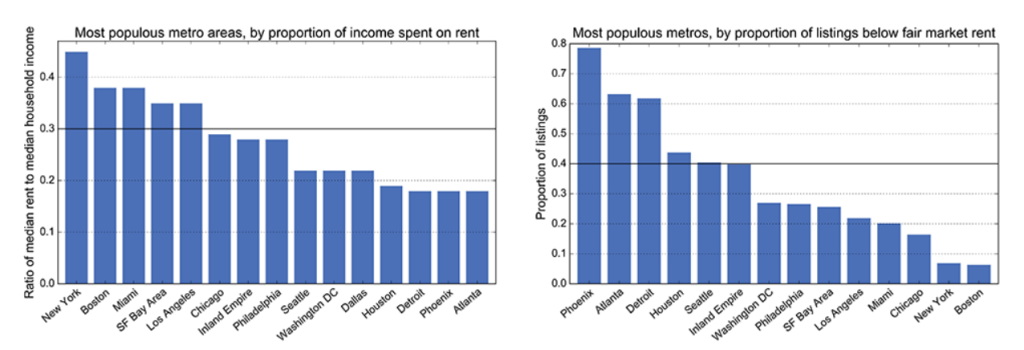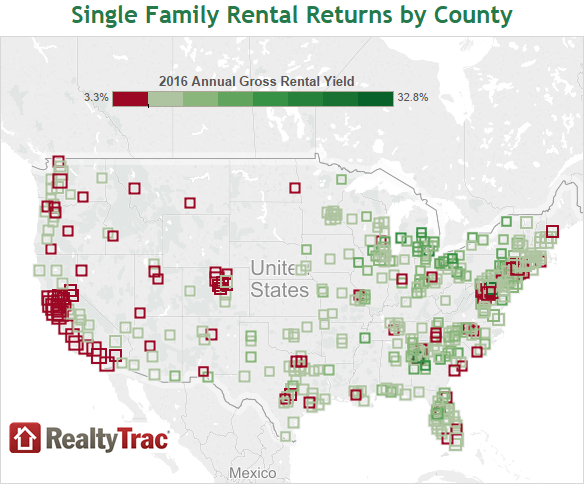As we approach the halfway point of 2016, we are in an optimal place to look at some of the trends that have dominated the California rental market these past few months, and determine if and how they may change going forward.
Many of the current trends are extensions of things we have seen in past years, while others are only coming to light very recently. But in thinking about one of the most complex and dynamic rental markets in the country, we were able to arrive at some of the biggest issues facing those who are interested in California rental property:
1. California continues to be the most expensive rental market in the country.
In a 2016 report about housing markets conducted by University of California, Berkeley, data from Craigslist was used to determine that California was dominant among the fifteen most expensive rental markets.
From the top most expensive rental areas, the California regions included were, in order:
- The San Francisco Bay area
- Santa Barbara
- Los Angeles
- Orange County
- Ventura
- San Diego
This is certainly not new information to those familiar with the rental market but just shows that trend has continued until 2016 and is likely to continue beyond. A 2016 survey of Los Angeles residents, for example, showed that 73% of them believed that housing prices will increase by the end of the year, a statistic that has itself increased over the past few years.
However, the cost of renting in the area was also measured against another similar data set that could prove even more interesting.
 Source: SSRN
Source: SSRN
2. The California market is incredibly dispersed.
In the same study, they also measured rent prices against the most populous metro areas. While three California areas were featured in the top fifteen-- the SF bay area, Los Angeles, and the Inland Empire-- this did not equal the six areas mentioned in the most expensive areas, even introducing a new area to the list, Inland Empire.
This data indicates that the California market manages to be both expensive and dispersed, making it a unique challenge in contrast to places like New York City, a typical urban environment that is expensive and condensed.

Source: SSRN
3. Many new laws are being enacted in an attempt to promote rental affordability.
According to the California Apartment Association, 2016 has brought a number of new housing laws aimed towards combatting rising prices in an attempt to better serve the low-income communities that are most affected by rising prices in the rental market.
Some of these, like AB 2, allows for increased community revitalization in lower-income parts of California in order to, among many other things, provide affordable housing. Another one, AB 744, makes it easier for rental property owners to offer housing options to potential low-income tenants.
A study from the University of California, Irvine analyzed the extent of incentives offered for developers to make low-income housing were effective, and they found that, while incentives did increase these efforts substantially, they were also not available in many areas. The author introduced the idea of “no-cost incentives” such as design flexibility and fast-track processing to assist in those areas.
The latter initiative was recently backed by Governor Jerry Brown of California, who supported legislation to help developers move much more quickly if they were interested in creating low-income housing.
This is important to remember in light of the numerous complexities that face the California housing market as a whole. While prices are on the rise, there is also a large movement towards affordable housing in order to affect those who were, and continue to be, most affected by the housing crash.
4. Smaller areas in California may yield surprisingly high rental yields in comparison to their more well-known counterparts.
Research conducted by RealtyTrac in 2016 listed a variety of different rental markets and their estimation on return for renters, and this had some interesting surprises for the state of California. Some of the areas investors might be interested in, according to this research, are:
- Merced: was ranked eighth among single-family rental markets, with 7.6% annual gross rental yield.
- Napa and Placer: also ranked among the same market, right next to each other in fourteenth and fifteenth.
- Santa Cruz: while being a more well-known area, nevertheless shows below the above areas in single-family rentals in seventeenth place.
- Alameda: appeared thirteenth in an interesting special study about specifically millennial-targeted single-family rentals.
- San Bernardino: pinpointed as having the best single-family rental returns in the state of California.
This research suggests that there is plenty of room for future growth in California, in these markets and others. While not all of these places have name recognition (even though many are closer to larger cities that do), California is just peppered with markets that are waiting to uncap their full potential.

5. Higher immigration rates than ever will impact the rental market.
According to data from the Department of Homeland Security, which was later reported by the Migration Policy Institute, California is undeniably the top site for immigration in the United States, seeing 10.5 million immigrant in 2014 and the fastest rate of absolute immigration growth between 2000 and 2014 at 2.5 million.
California has continued to be on the news for these issues and others in 2016: there have been many debates about providing health care to undocumented immigrants, for example, and the climate regarding issues of immigration, undocumented or documented, is creating an uncertain climate with regards to the rental market.
Putting these statistics together with the previous ones about the price of renting in California has certainly created a challenge for the state, since it must keep up with the rising Californian population as well.
In many ways, it has proved difficult to generalize about trends in California market since it is such a unique state in its distribution of rental markets. The researchers behind the earlier UC - Berkeley study admitted this as an obstacle to study and analysis, claiming:
“In many ways, California’s climate, geography, affluence, and land-use policies make it an anomaly (Fulton and Shigley 2012), and the Craigslist data reveal different spatial patterns elsewhere in the country.”
However, this complexity is likely to interest renters and investors more than hinder them. The potential for growth in the region is equal to the housing challenges that are facing it, and with many laws working to combat the issues in the area, it is likely that we will see a more sustainable market being created in the future.



